Critical Review of Change Management Theories: BMGT7006 Report
VerifiedAdded on 2022/08/24
|11
|2631
|20
Report
AI Summary
This report presents a critical review of Rune Todnem's article, "Organisational Change Management: A Critical Review." The student analyzes the article, which examines various change management theories and approaches, including those of Kotter, Kanter, and Lewin. The review highlights the importance of effective change management in today's competitive business environment and critiques existing frameworks, noting contradictions and a lack of empirical evidence. The report summarizes the article's discussion of discontinuous, incremental, planned, emergent, and contingency change, while also providing a critical analysis of the strengths and weaknesses of the different approaches. The student concludes by emphasizing the need for new frameworks and further research in organizational change management, aligned with the article's recommendations.
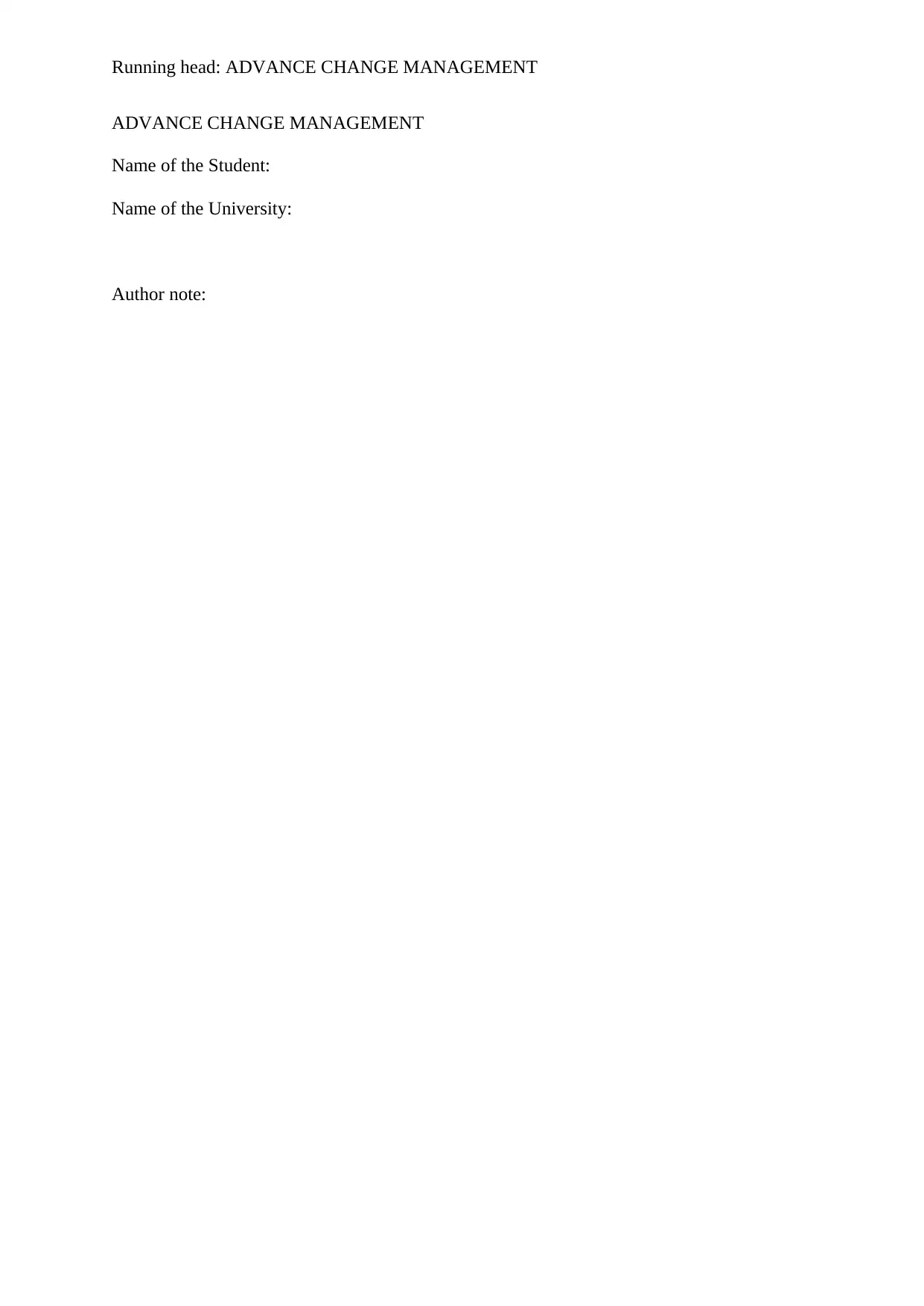
Running head: ADVANCE CHANGE MANAGEMENT
ADVANCE CHANGE MANAGEMENT
Name of the Student:
Name of the University:
Author note:
ADVANCE CHANGE MANAGEMENT
Name of the Student:
Name of the University:
Author note:
Paraphrase This Document
Need a fresh take? Get an instant paraphrase of this document with our AI Paraphraser
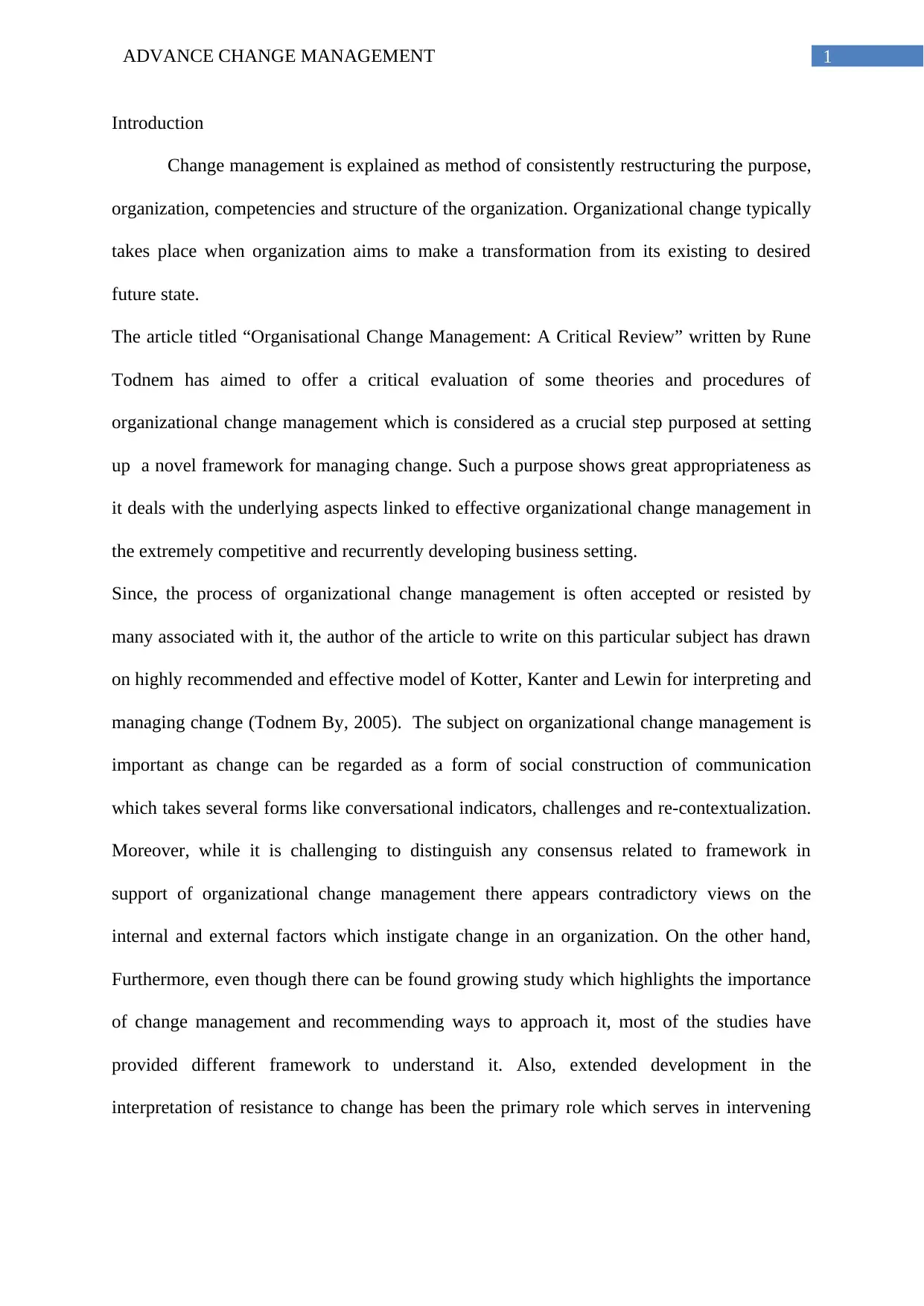
1ADVANCE CHANGE MANAGEMENT
Introduction
Change management is explained as method of consistently restructuring the purpose,
organization, competencies and structure of the organization. Organizational change typically
takes place when organization aims to make a transformation from its existing to desired
future state.
The article titled “Organisational Change Management: A Critical Review” written by Rune
Todnem has aimed to offer a critical evaluation of some theories and procedures of
organizational change management which is considered as a crucial step purposed at setting
up a novel framework for managing change. Such a purpose shows great appropriateness as
it deals with the underlying aspects linked to effective organizational change management in
the extremely competitive and recurrently developing business setting.
Since, the process of organizational change management is often accepted or resisted by
many associated with it, the author of the article to write on this particular subject has drawn
on highly recommended and effective model of Kotter, Kanter and Lewin for interpreting and
managing change (Todnem By, 2005). The subject on organizational change management is
important as change can be regarded as a form of social construction of communication
which takes several forms like conversational indicators, challenges and re-contextualization.
Moreover, while it is challenging to distinguish any consensus related to framework in
support of organizational change management there appears contradictory views on the
internal and external factors which instigate change in an organization. On the other hand,
Furthermore, even though there can be found growing study which highlights the importance
of change management and recommending ways to approach it, most of the studies have
provided different framework to understand it. Also, extended development in the
interpretation of resistance to change has been the primary role which serves in intervening
Introduction
Change management is explained as method of consistently restructuring the purpose,
organization, competencies and structure of the organization. Organizational change typically
takes place when organization aims to make a transformation from its existing to desired
future state.
The article titled “Organisational Change Management: A Critical Review” written by Rune
Todnem has aimed to offer a critical evaluation of some theories and procedures of
organizational change management which is considered as a crucial step purposed at setting
up a novel framework for managing change. Such a purpose shows great appropriateness as
it deals with the underlying aspects linked to effective organizational change management in
the extremely competitive and recurrently developing business setting.
Since, the process of organizational change management is often accepted or resisted by
many associated with it, the author of the article to write on this particular subject has drawn
on highly recommended and effective model of Kotter, Kanter and Lewin for interpreting and
managing change (Todnem By, 2005). The subject on organizational change management is
important as change can be regarded as a form of social construction of communication
which takes several forms like conversational indicators, challenges and re-contextualization.
Moreover, while it is challenging to distinguish any consensus related to framework in
support of organizational change management there appears contradictory views on the
internal and external factors which instigate change in an organization. On the other hand,
Furthermore, even though there can be found growing study which highlights the importance
of change management and recommending ways to approach it, most of the studies have
provided different framework to understand it. Also, extended development in the
interpretation of resistance to change has been the primary role which serves in intervening
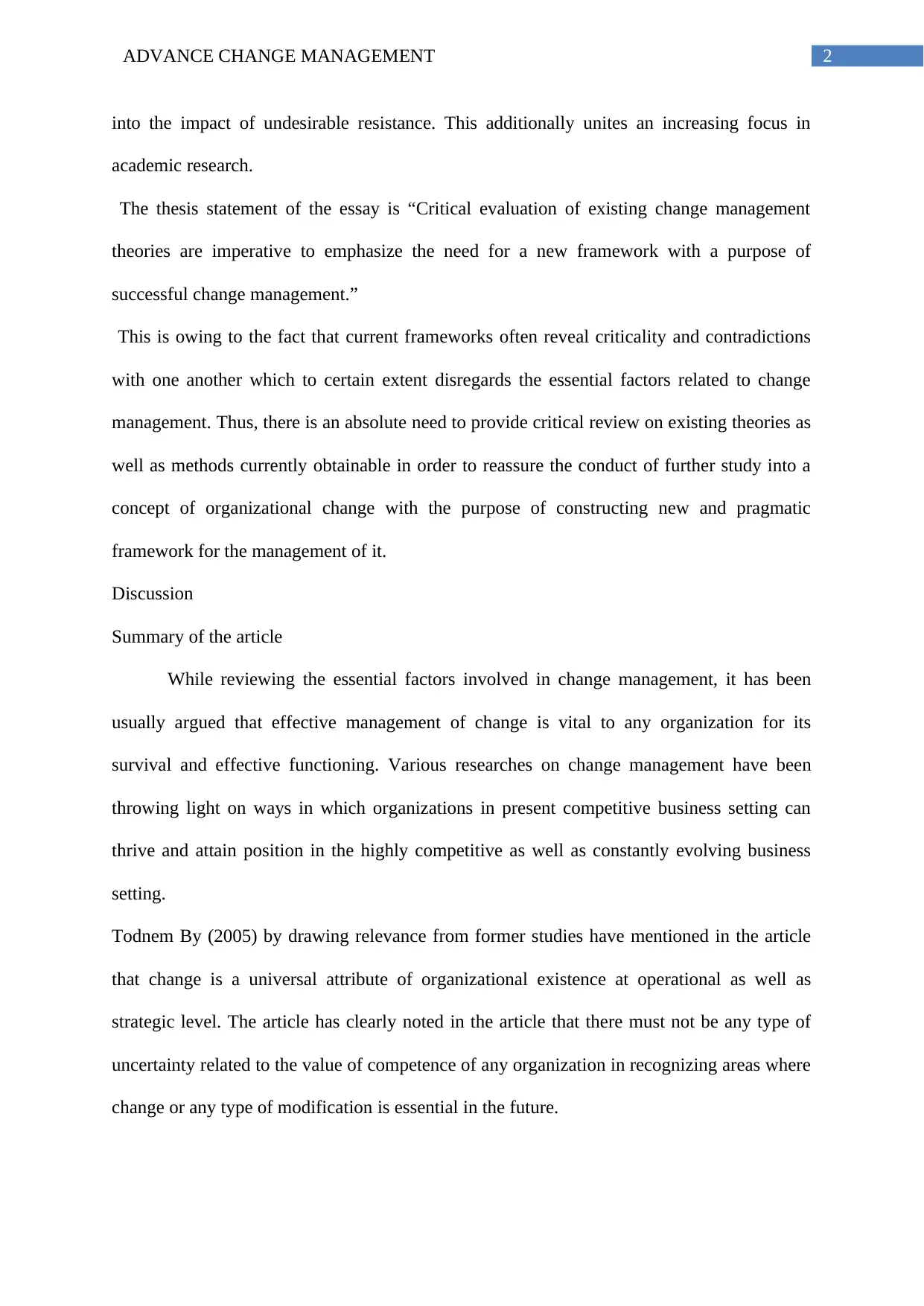
2ADVANCE CHANGE MANAGEMENT
into the impact of undesirable resistance. This additionally unites an increasing focus in
academic research.
The thesis statement of the essay is “Critical evaluation of existing change management
theories are imperative to emphasize the need for a new framework with a purpose of
successful change management.”
This is owing to the fact that current frameworks often reveal criticality and contradictions
with one another which to certain extent disregards the essential factors related to change
management. Thus, there is an absolute need to provide critical review on existing theories as
well as methods currently obtainable in order to reassure the conduct of further study into a
concept of organizational change with the purpose of constructing new and pragmatic
framework for the management of it.
Discussion
Summary of the article
While reviewing the essential factors involved in change management, it has been
usually argued that effective management of change is vital to any organization for its
survival and effective functioning. Various researches on change management have been
throwing light on ways in which organizations in present competitive business setting can
thrive and attain position in the highly competitive as well as constantly evolving business
setting.
Todnem By (2005) by drawing relevance from former studies have mentioned in the article
that change is a universal attribute of organizational existence at operational as well as
strategic level. The article has clearly noted in the article that there must not be any type of
uncertainty related to the value of competence of any organization in recognizing areas where
change or any type of modification is essential in the future.
into the impact of undesirable resistance. This additionally unites an increasing focus in
academic research.
The thesis statement of the essay is “Critical evaluation of existing change management
theories are imperative to emphasize the need for a new framework with a purpose of
successful change management.”
This is owing to the fact that current frameworks often reveal criticality and contradictions
with one another which to certain extent disregards the essential factors related to change
management. Thus, there is an absolute need to provide critical review on existing theories as
well as methods currently obtainable in order to reassure the conduct of further study into a
concept of organizational change with the purpose of constructing new and pragmatic
framework for the management of it.
Discussion
Summary of the article
While reviewing the essential factors involved in change management, it has been
usually argued that effective management of change is vital to any organization for its
survival and effective functioning. Various researches on change management have been
throwing light on ways in which organizations in present competitive business setting can
thrive and attain position in the highly competitive as well as constantly evolving business
setting.
Todnem By (2005) by drawing relevance from former studies have mentioned in the article
that change is a universal attribute of organizational existence at operational as well as
strategic level. The article has clearly noted in the article that there must not be any type of
uncertainty related to the value of competence of any organization in recognizing areas where
change or any type of modification is essential in the future.
⊘ This is a preview!⊘
Do you want full access?
Subscribe today to unlock all pages.

Trusted by 1+ million students worldwide
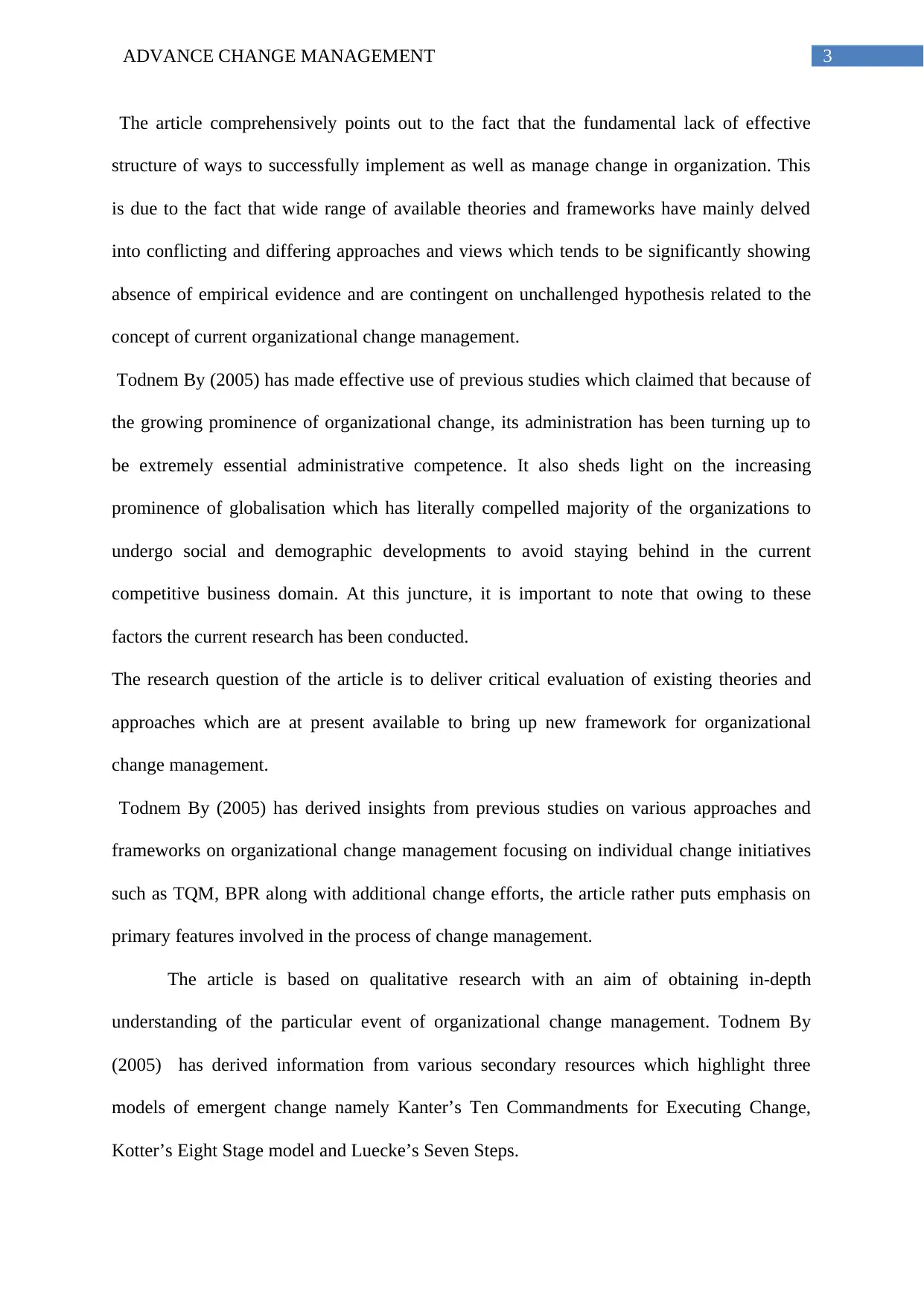
3ADVANCE CHANGE MANAGEMENT
The article comprehensively points out to the fact that the fundamental lack of effective
structure of ways to successfully implement as well as manage change in organization. This
is due to the fact that wide range of available theories and frameworks have mainly delved
into conflicting and differing approaches and views which tends to be significantly showing
absence of empirical evidence and are contingent on unchallenged hypothesis related to the
concept of current organizational change management.
Todnem By (2005) has made effective use of previous studies which claimed that because of
the growing prominence of organizational change, its administration has been turning up to
be extremely essential administrative competence. It also sheds light on the increasing
prominence of globalisation which has literally compelled majority of the organizations to
undergo social and demographic developments to avoid staying behind in the current
competitive business domain. At this juncture, it is important to note that owing to these
factors the current research has been conducted.
The research question of the article is to deliver critical evaluation of existing theories and
approaches which are at present available to bring up new framework for organizational
change management.
Todnem By (2005) has derived insights from previous studies on various approaches and
frameworks on organizational change management focusing on individual change initiatives
such as TQM, BPR along with additional change efforts, the article rather puts emphasis on
primary features involved in the process of change management.
The article is based on qualitative research with an aim of obtaining in-depth
understanding of the particular event of organizational change management. Todnem By
(2005) has derived information from various secondary resources which highlight three
models of emergent change namely Kanter’s Ten Commandments for Executing Change,
Kotter’s Eight Stage model and Luecke’s Seven Steps.
The article comprehensively points out to the fact that the fundamental lack of effective
structure of ways to successfully implement as well as manage change in organization. This
is due to the fact that wide range of available theories and frameworks have mainly delved
into conflicting and differing approaches and views which tends to be significantly showing
absence of empirical evidence and are contingent on unchallenged hypothesis related to the
concept of current organizational change management.
Todnem By (2005) has made effective use of previous studies which claimed that because of
the growing prominence of organizational change, its administration has been turning up to
be extremely essential administrative competence. It also sheds light on the increasing
prominence of globalisation which has literally compelled majority of the organizations to
undergo social and demographic developments to avoid staying behind in the current
competitive business domain. At this juncture, it is important to note that owing to these
factors the current research has been conducted.
The research question of the article is to deliver critical evaluation of existing theories and
approaches which are at present available to bring up new framework for organizational
change management.
Todnem By (2005) has derived insights from previous studies on various approaches and
frameworks on organizational change management focusing on individual change initiatives
such as TQM, BPR along with additional change efforts, the article rather puts emphasis on
primary features involved in the process of change management.
The article is based on qualitative research with an aim of obtaining in-depth
understanding of the particular event of organizational change management. Todnem By
(2005) has derived information from various secondary resources which highlight three
models of emergent change namely Kanter’s Ten Commandments for Executing Change,
Kotter’s Eight Stage model and Luecke’s Seven Steps.
Paraphrase This Document
Need a fresh take? Get an instant paraphrase of this document with our AI Paraphraser
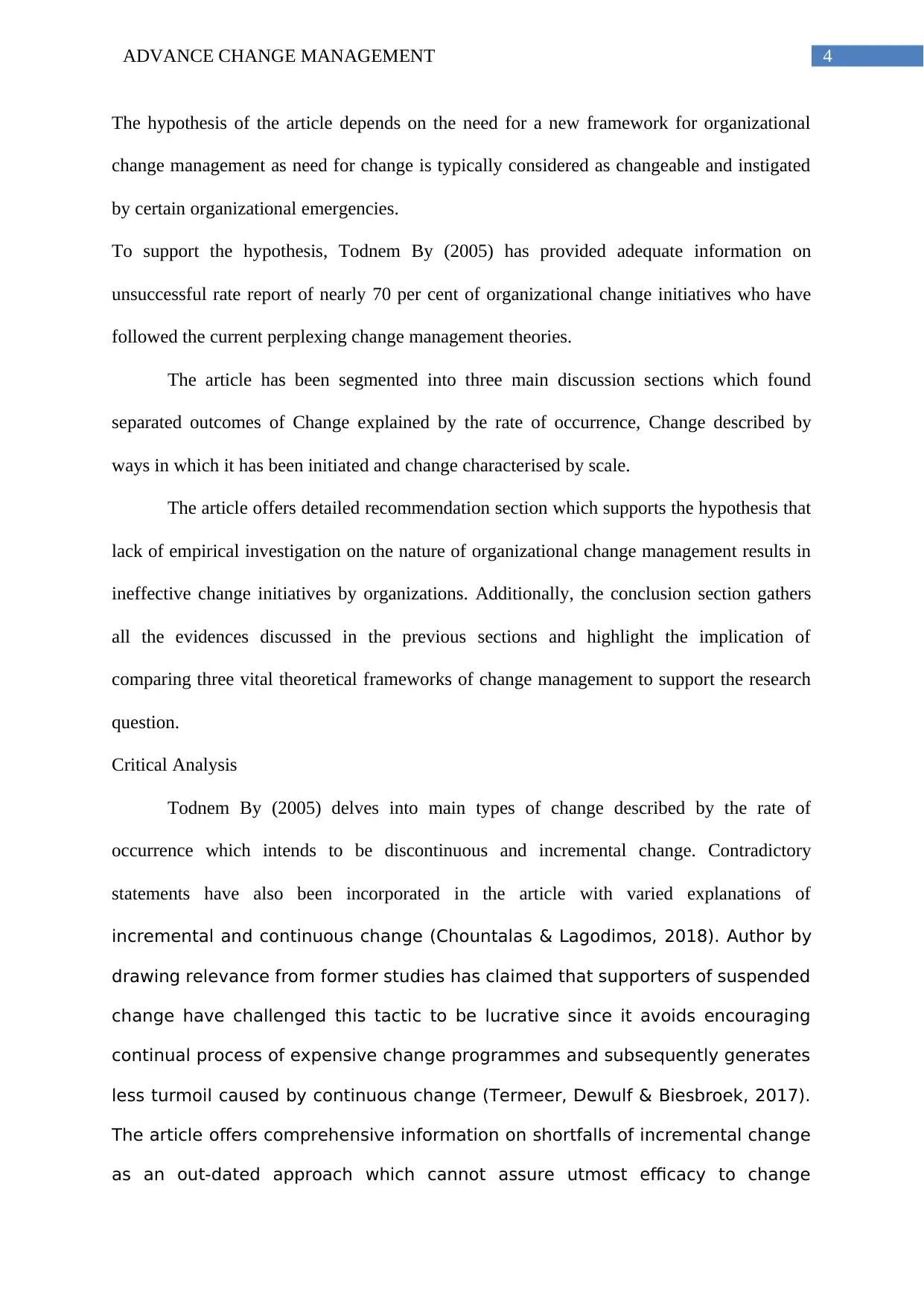
4ADVANCE CHANGE MANAGEMENT
The hypothesis of the article depends on the need for a new framework for organizational
change management as need for change is typically considered as changeable and instigated
by certain organizational emergencies.
To support the hypothesis, Todnem By (2005) has provided adequate information on
unsuccessful rate report of nearly 70 per cent of organizational change initiatives who have
followed the current perplexing change management theories.
The article has been segmented into three main discussion sections which found
separated outcomes of Change explained by the rate of occurrence, Change described by
ways in which it has been initiated and change characterised by scale.
The article offers detailed recommendation section which supports the hypothesis that
lack of empirical investigation on the nature of organizational change management results in
ineffective change initiatives by organizations. Additionally, the conclusion section gathers
all the evidences discussed in the previous sections and highlight the implication of
comparing three vital theoretical frameworks of change management to support the research
question.
Critical Analysis
Todnem By (2005) delves into main types of change described by the rate of
occurrence which intends to be discontinuous and incremental change. Contradictory
statements have also been incorporated in the article with varied explanations of
incremental and continuous change (Chountalas & Lagodimos, 2018). Author by
drawing relevance from former studies has claimed that supporters of suspended
change have challenged this tactic to be lucrative since it avoids encouraging
continual process of expensive change programmes and subsequently generates
less turmoil caused by continuous change (Termeer, Dewulf & Biesbroek, 2017).
The article offers comprehensive information on shortfalls of incremental change
as an out-dated approach which cannot assure utmost efficacy to change
The hypothesis of the article depends on the need for a new framework for organizational
change management as need for change is typically considered as changeable and instigated
by certain organizational emergencies.
To support the hypothesis, Todnem By (2005) has provided adequate information on
unsuccessful rate report of nearly 70 per cent of organizational change initiatives who have
followed the current perplexing change management theories.
The article has been segmented into three main discussion sections which found
separated outcomes of Change explained by the rate of occurrence, Change described by
ways in which it has been initiated and change characterised by scale.
The article offers detailed recommendation section which supports the hypothesis that
lack of empirical investigation on the nature of organizational change management results in
ineffective change initiatives by organizations. Additionally, the conclusion section gathers
all the evidences discussed in the previous sections and highlight the implication of
comparing three vital theoretical frameworks of change management to support the research
question.
Critical Analysis
Todnem By (2005) delves into main types of change described by the rate of
occurrence which intends to be discontinuous and incremental change. Contradictory
statements have also been incorporated in the article with varied explanations of
incremental and continuous change (Chountalas & Lagodimos, 2018). Author by
drawing relevance from former studies has claimed that supporters of suspended
change have challenged this tactic to be lucrative since it avoids encouraging
continual process of expensive change programmes and subsequently generates
less turmoil caused by continuous change (Termeer, Dewulf & Biesbroek, 2017).
The article offers comprehensive information on shortfalls of incremental change
as an out-dated approach which cannot assure utmost efficacy to change
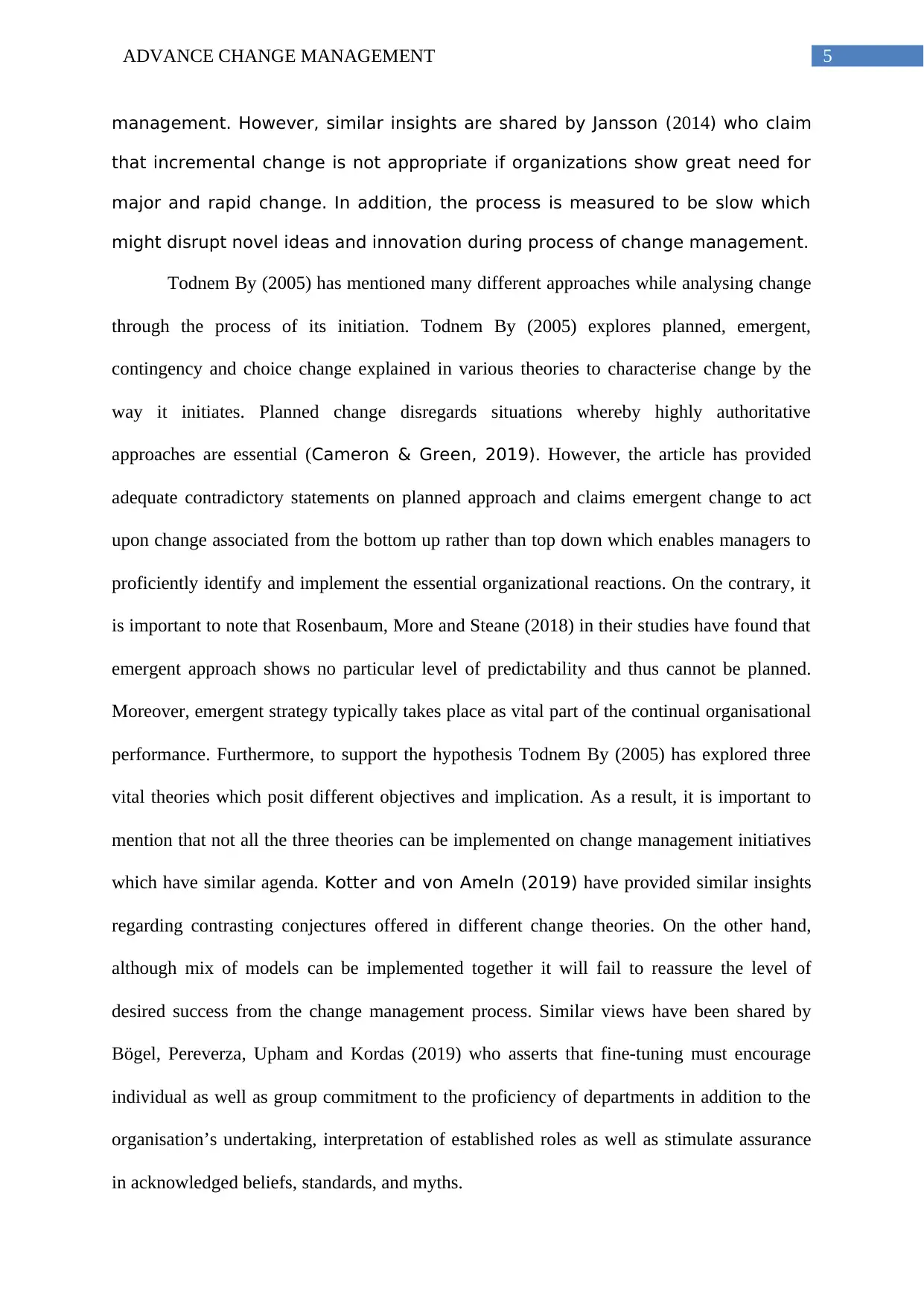
5ADVANCE CHANGE MANAGEMENT
management. However, similar insights are shared by Jansson (2014) who claim
that incremental change is not appropriate if organizations show great need for
major and rapid change. In addition, the process is measured to be slow which
might disrupt novel ideas and innovation during process of change management.
Todnem By (2005) has mentioned many different approaches while analysing change
through the process of its initiation. Todnem By (2005) explores planned, emergent,
contingency and choice change explained in various theories to characterise change by the
way it initiates. Planned change disregards situations whereby highly authoritative
approaches are essential (Cameron & Green, 2019). However, the article has provided
adequate contradictory statements on planned approach and claims emergent change to act
upon change associated from the bottom up rather than top down which enables managers to
proficiently identify and implement the essential organizational reactions. On the contrary, it
is important to note that Rosenbaum, More and Steane (2018) in their studies have found that
emergent approach shows no particular level of predictability and thus cannot be planned.
Moreover, emergent strategy typically takes place as vital part of the continual organisational
performance. Furthermore, to support the hypothesis Todnem By (2005) has explored three
vital theories which posit different objectives and implication. As a result, it is important to
mention that not all the three theories can be implemented on change management initiatives
which have similar agenda. Kotter and von Ameln (2019) have provided similar insights
regarding contrasting conjectures offered in different change theories. On the other hand,
although mix of models can be implemented together it will fail to reassure the level of
desired success from the change management process. Similar views have been shared by
Bögel, Pereverza, Upham and Kordas (2019) who asserts that fine-tuning must encourage
individual as well as group commitment to the proficiency of departments in addition to the
organisation’s undertaking, interpretation of established roles as well as stimulate assurance
in acknowledged beliefs, standards, and myths.
management. However, similar insights are shared by Jansson (2014) who claim
that incremental change is not appropriate if organizations show great need for
major and rapid change. In addition, the process is measured to be slow which
might disrupt novel ideas and innovation during process of change management.
Todnem By (2005) has mentioned many different approaches while analysing change
through the process of its initiation. Todnem By (2005) explores planned, emergent,
contingency and choice change explained in various theories to characterise change by the
way it initiates. Planned change disregards situations whereby highly authoritative
approaches are essential (Cameron & Green, 2019). However, the article has provided
adequate contradictory statements on planned approach and claims emergent change to act
upon change associated from the bottom up rather than top down which enables managers to
proficiently identify and implement the essential organizational reactions. On the contrary, it
is important to note that Rosenbaum, More and Steane (2018) in their studies have found that
emergent approach shows no particular level of predictability and thus cannot be planned.
Moreover, emergent strategy typically takes place as vital part of the continual organisational
performance. Furthermore, to support the hypothesis Todnem By (2005) has explored three
vital theories which posit different objectives and implication. As a result, it is important to
mention that not all the three theories can be implemented on change management initiatives
which have similar agenda. Kotter and von Ameln (2019) have provided similar insights
regarding contrasting conjectures offered in different change theories. On the other hand,
although mix of models can be implemented together it will fail to reassure the level of
desired success from the change management process. Similar views have been shared by
Bögel, Pereverza, Upham and Kordas (2019) who asserts that fine-tuning must encourage
individual as well as group commitment to the proficiency of departments in addition to the
organisation’s undertaking, interpretation of established roles as well as stimulate assurance
in acknowledged beliefs, standards, and myths.
⊘ This is a preview!⊘
Do you want full access?
Subscribe today to unlock all pages.

Trusted by 1+ million students worldwide
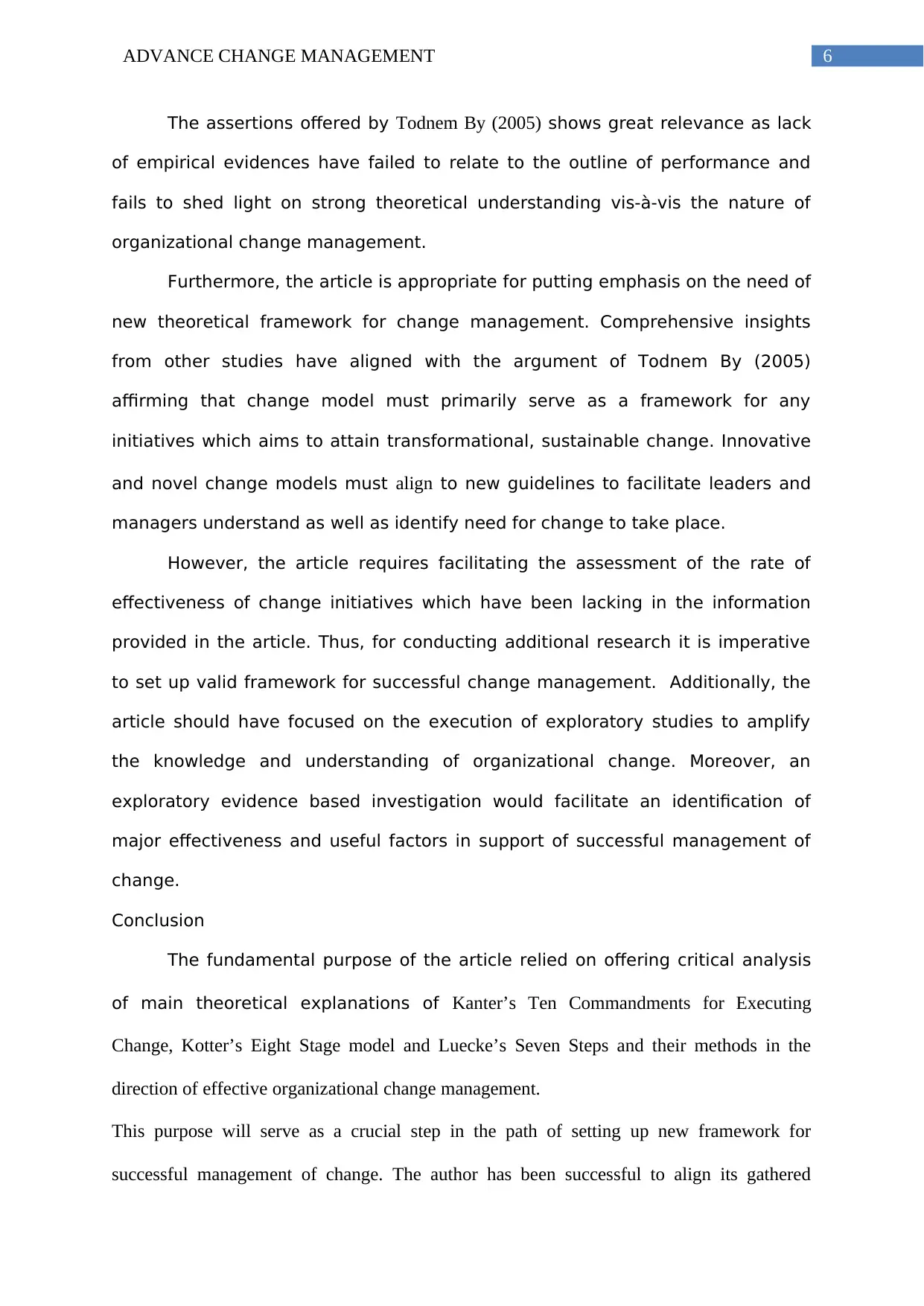
6ADVANCE CHANGE MANAGEMENT
The assertions offered by Todnem By (2005) shows great relevance as lack
of empirical evidences have failed to relate to the outline of performance and
fails to shed light on strong theoretical understanding vis-à-vis the nature of
organizational change management.
Furthermore, the article is appropriate for putting emphasis on the need of
new theoretical framework for change management. Comprehensive insights
from other studies have aligned with the argument of Todnem By (2005)
affirming that change model must primarily serve as a framework for any
initiatives which aims to attain transformational, sustainable change. Innovative
and novel change models must align to new guidelines to facilitate leaders and
managers understand as well as identify need for change to take place.
However, the article requires facilitating the assessment of the rate of
effectiveness of change initiatives which have been lacking in the information
provided in the article. Thus, for conducting additional research it is imperative
to set up valid framework for successful change management. Additionally, the
article should have focused on the execution of exploratory studies to amplify
the knowledge and understanding of organizational change. Moreover, an
exploratory evidence based investigation would facilitate an identification of
major effectiveness and useful factors in support of successful management of
change.
Conclusion
The fundamental purpose of the article relied on offering critical analysis
of main theoretical explanations of Kanter’s Ten Commandments for Executing
Change, Kotter’s Eight Stage model and Luecke’s Seven Steps and their methods in the
direction of effective organizational change management.
This purpose will serve as a crucial step in the path of setting up new framework for
successful management of change. The author has been successful to align its gathered
The assertions offered by Todnem By (2005) shows great relevance as lack
of empirical evidences have failed to relate to the outline of performance and
fails to shed light on strong theoretical understanding vis-à-vis the nature of
organizational change management.
Furthermore, the article is appropriate for putting emphasis on the need of
new theoretical framework for change management. Comprehensive insights
from other studies have aligned with the argument of Todnem By (2005)
affirming that change model must primarily serve as a framework for any
initiatives which aims to attain transformational, sustainable change. Innovative
and novel change models must align to new guidelines to facilitate leaders and
managers understand as well as identify need for change to take place.
However, the article requires facilitating the assessment of the rate of
effectiveness of change initiatives which have been lacking in the information
provided in the article. Thus, for conducting additional research it is imperative
to set up valid framework for successful change management. Additionally, the
article should have focused on the execution of exploratory studies to amplify
the knowledge and understanding of organizational change. Moreover, an
exploratory evidence based investigation would facilitate an identification of
major effectiveness and useful factors in support of successful management of
change.
Conclusion
The fundamental purpose of the article relied on offering critical analysis
of main theoretical explanations of Kanter’s Ten Commandments for Executing
Change, Kotter’s Eight Stage model and Luecke’s Seven Steps and their methods in the
direction of effective organizational change management.
This purpose will serve as a crucial step in the path of setting up new framework for
successful management of change. The author has been successful to align its gathered
Paraphrase This Document
Need a fresh take? Get an instant paraphrase of this document with our AI Paraphraser
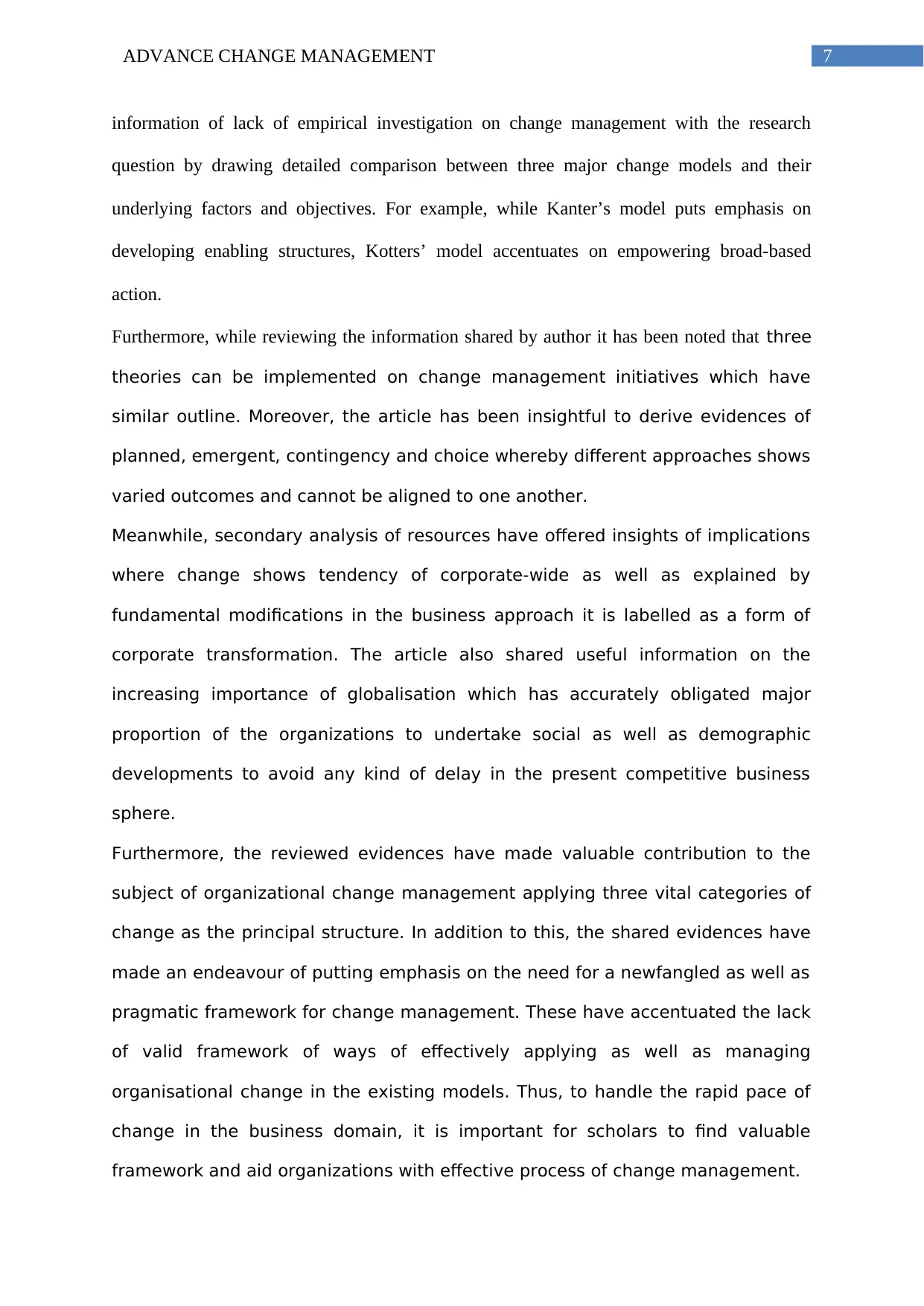
7ADVANCE CHANGE MANAGEMENT
information of lack of empirical investigation on change management with the research
question by drawing detailed comparison between three major change models and their
underlying factors and objectives. For example, while Kanter’s model puts emphasis on
developing enabling structures, Kotters’ model accentuates on empowering broad-based
action.
Furthermore, while reviewing the information shared by author it has been noted that three
theories can be implemented on change management initiatives which have
similar outline. Moreover, the article has been insightful to derive evidences of
planned, emergent, contingency and choice whereby different approaches shows
varied outcomes and cannot be aligned to one another.
Meanwhile, secondary analysis of resources have offered insights of implications
where change shows tendency of corporate-wide as well as explained by
fundamental modifications in the business approach it is labelled as a form of
corporate transformation. The article also shared useful information on the
increasing importance of globalisation which has accurately obligated major
proportion of the organizations to undertake social as well as demographic
developments to avoid any kind of delay in the present competitive business
sphere.
Furthermore, the reviewed evidences have made valuable contribution to the
subject of organizational change management applying three vital categories of
change as the principal structure. In addition to this, the shared evidences have
made an endeavour of putting emphasis on the need for a newfangled as well as
pragmatic framework for change management. These have accentuated the lack
of valid framework of ways of effectively applying as well as managing
organisational change in the existing models. Thus, to handle the rapid pace of
change in the business domain, it is important for scholars to find valuable
framework and aid organizations with effective process of change management.
information of lack of empirical investigation on change management with the research
question by drawing detailed comparison between three major change models and their
underlying factors and objectives. For example, while Kanter’s model puts emphasis on
developing enabling structures, Kotters’ model accentuates on empowering broad-based
action.
Furthermore, while reviewing the information shared by author it has been noted that three
theories can be implemented on change management initiatives which have
similar outline. Moreover, the article has been insightful to derive evidences of
planned, emergent, contingency and choice whereby different approaches shows
varied outcomes and cannot be aligned to one another.
Meanwhile, secondary analysis of resources have offered insights of implications
where change shows tendency of corporate-wide as well as explained by
fundamental modifications in the business approach it is labelled as a form of
corporate transformation. The article also shared useful information on the
increasing importance of globalisation which has accurately obligated major
proportion of the organizations to undertake social as well as demographic
developments to avoid any kind of delay in the present competitive business
sphere.
Furthermore, the reviewed evidences have made valuable contribution to the
subject of organizational change management applying three vital categories of
change as the principal structure. In addition to this, the shared evidences have
made an endeavour of putting emphasis on the need for a newfangled as well as
pragmatic framework for change management. These have accentuated the lack
of valid framework of ways of effectively applying as well as managing
organisational change in the existing models. Thus, to handle the rapid pace of
change in the business domain, it is important for scholars to find valuable
framework and aid organizations with effective process of change management.

8ADVANCE CHANGE MANAGEMENT
⊘ This is a preview!⊘
Do you want full access?
Subscribe today to unlock all pages.

Trusted by 1+ million students worldwide
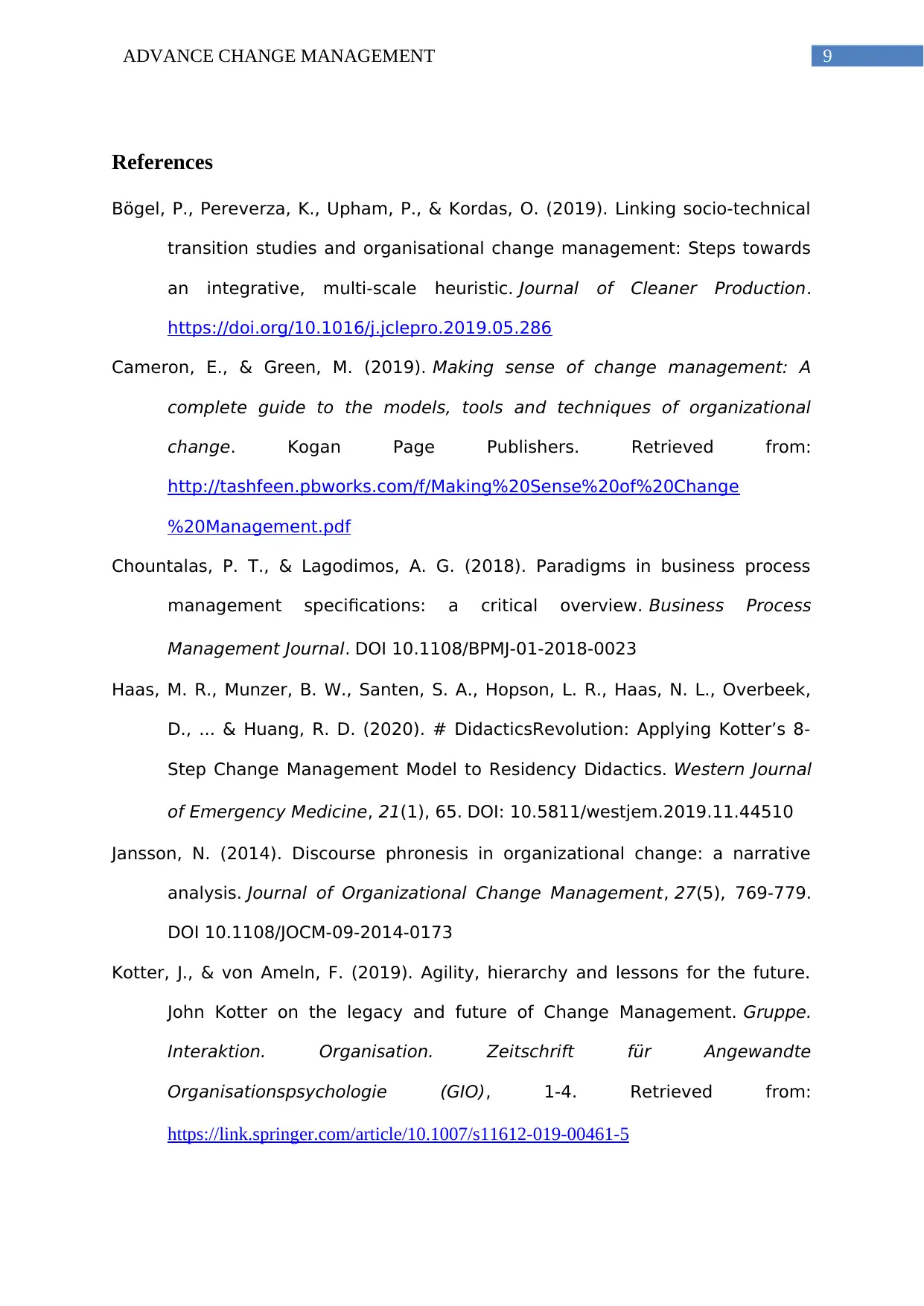
9ADVANCE CHANGE MANAGEMENT
References
Bögel, P., Pereverza, K., Upham, P., & Kordas, O. (2019). Linking socio-technical
transition studies and organisational change management: Steps towards
an integrative, multi-scale heuristic. Journal of Cleaner Production.
https://doi.org/10.1016/j.jclepro.2019.05.286
Cameron, E., & Green, M. (2019). Making sense of change management: A
complete guide to the models, tools and techniques of organizational
change. Kogan Page Publishers. Retrieved from:
http://tashfeen.pbworks.com/f/Making%20Sense%20of%20Change
%20Management.pdf
Chountalas, P. T., & Lagodimos, A. G. (2018). Paradigms in business process
management specifications: a critical overview. Business Process
Management Journal. DOI 10.1108/BPMJ-01-2018-0023
Haas, M. R., Munzer, B. W., Santen, S. A., Hopson, L. R., Haas, N. L., Overbeek,
D., ... & Huang, R. D. (2020). # DidacticsRevolution: Applying Kotter’s 8-
Step Change Management Model to Residency Didactics. Western Journal
of Emergency Medicine, 21(1), 65. DOI: 10.5811/westjem.2019.11.44510
Jansson, N. (2014). Discourse phronesis in organizational change: a narrative
analysis. Journal of Organizational Change Management, 27(5), 769-779.
DOI 10.1108/JOCM-09-2014-0173
Kotter, J., & von Ameln, F. (2019). Agility, hierarchy and lessons for the future.
John Kotter on the legacy and future of Change Management. Gruppe.
Interaktion. Organisation. Zeitschrift für Angewandte
Organisationspsychologie (GIO), 1-4. Retrieved from:
https://link.springer.com/article/10.1007/s11612-019-00461-5
References
Bögel, P., Pereverza, K., Upham, P., & Kordas, O. (2019). Linking socio-technical
transition studies and organisational change management: Steps towards
an integrative, multi-scale heuristic. Journal of Cleaner Production.
https://doi.org/10.1016/j.jclepro.2019.05.286
Cameron, E., & Green, M. (2019). Making sense of change management: A
complete guide to the models, tools and techniques of organizational
change. Kogan Page Publishers. Retrieved from:
http://tashfeen.pbworks.com/f/Making%20Sense%20of%20Change
%20Management.pdf
Chountalas, P. T., & Lagodimos, A. G. (2018). Paradigms in business process
management specifications: a critical overview. Business Process
Management Journal. DOI 10.1108/BPMJ-01-2018-0023
Haas, M. R., Munzer, B. W., Santen, S. A., Hopson, L. R., Haas, N. L., Overbeek,
D., ... & Huang, R. D. (2020). # DidacticsRevolution: Applying Kotter’s 8-
Step Change Management Model to Residency Didactics. Western Journal
of Emergency Medicine, 21(1), 65. DOI: 10.5811/westjem.2019.11.44510
Jansson, N. (2014). Discourse phronesis in organizational change: a narrative
analysis. Journal of Organizational Change Management, 27(5), 769-779.
DOI 10.1108/JOCM-09-2014-0173
Kotter, J., & von Ameln, F. (2019). Agility, hierarchy and lessons for the future.
John Kotter on the legacy and future of Change Management. Gruppe.
Interaktion. Organisation. Zeitschrift für Angewandte
Organisationspsychologie (GIO), 1-4. Retrieved from:
https://link.springer.com/article/10.1007/s11612-019-00461-5
Paraphrase This Document
Need a fresh take? Get an instant paraphrase of this document with our AI Paraphraser
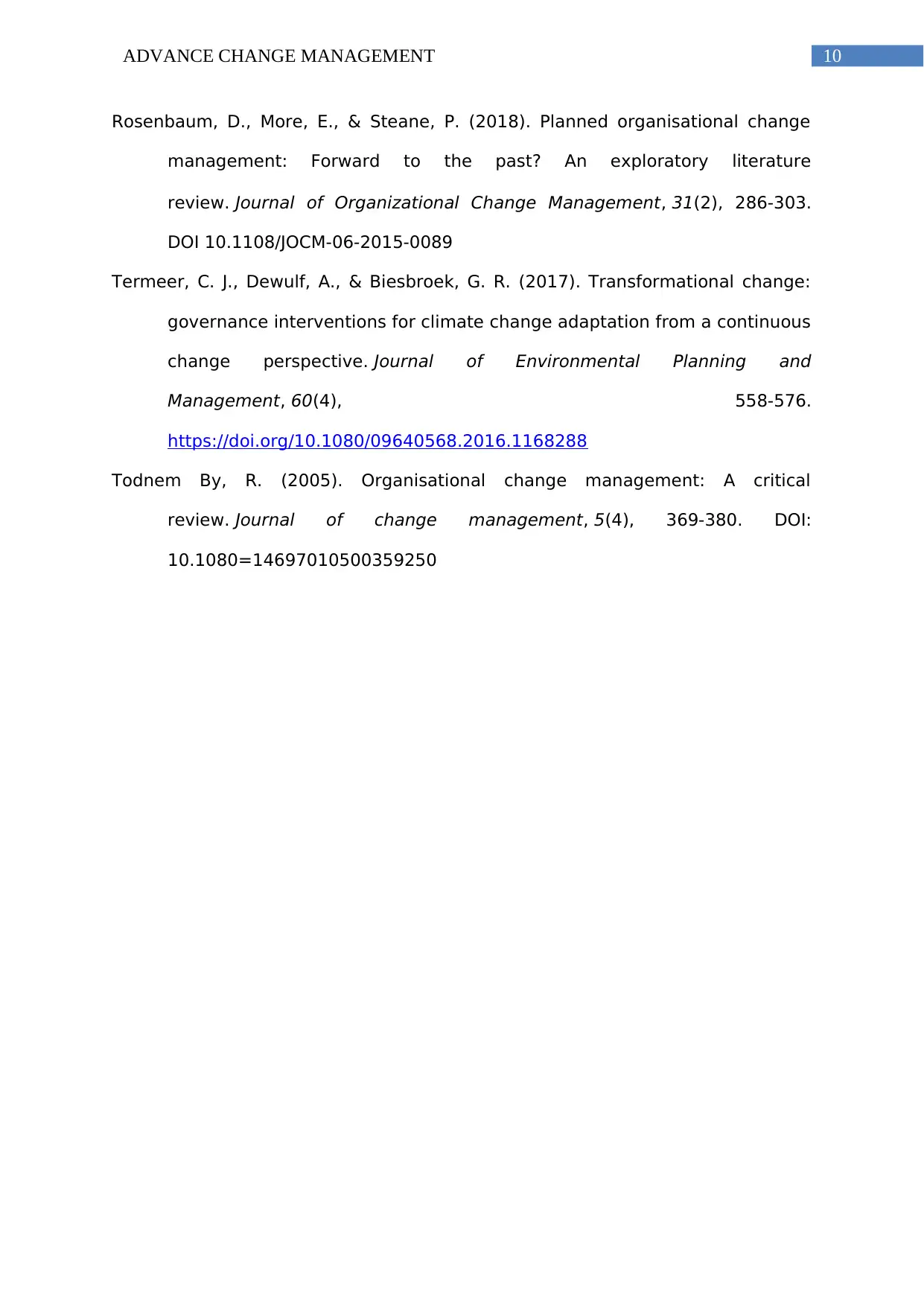
10ADVANCE CHANGE MANAGEMENT
Rosenbaum, D., More, E., & Steane, P. (2018). Planned organisational change
management: Forward to the past? An exploratory literature
review. Journal of Organizational Change Management, 31(2), 286-303.
DOI 10.1108/JOCM-06-2015-0089
Termeer, C. J., Dewulf, A., & Biesbroek, G. R. (2017). Transformational change:
governance interventions for climate change adaptation from a continuous
change perspective. Journal of Environmental Planning and
Management, 60(4), 558-576.
https://doi.org/10.1080/09640568.2016.1168288
Todnem By, R. (2005). Organisational change management: A critical
review. Journal of change management, 5(4), 369-380. DOI:
10.1080=14697010500359250
Rosenbaum, D., More, E., & Steane, P. (2018). Planned organisational change
management: Forward to the past? An exploratory literature
review. Journal of Organizational Change Management, 31(2), 286-303.
DOI 10.1108/JOCM-06-2015-0089
Termeer, C. J., Dewulf, A., & Biesbroek, G. R. (2017). Transformational change:
governance interventions for climate change adaptation from a continuous
change perspective. Journal of Environmental Planning and
Management, 60(4), 558-576.
https://doi.org/10.1080/09640568.2016.1168288
Todnem By, R. (2005). Organisational change management: A critical
review. Journal of change management, 5(4), 369-380. DOI:
10.1080=14697010500359250
1 out of 11
Related Documents
Your All-in-One AI-Powered Toolkit for Academic Success.
+13062052269
info@desklib.com
Available 24*7 on WhatsApp / Email
![[object Object]](/_next/static/media/star-bottom.7253800d.svg)
Unlock your academic potential
Copyright © 2020–2025 A2Z Services. All Rights Reserved. Developed and managed by ZUCOL.





